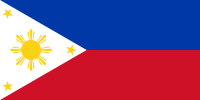List of Intangible Cultural Heritage elements in the Philippines

The United Nations Educational, Scientific and Cultural Organisation (UNESCO) intangible cultural heritage elements are the non-physical traditions and practices performed by a people. As part of a country's cultural heritage, they include celebrations, festivals, performances, oral traditions, music, and the making of handicrafts.[1] The "intangible cultural heritage" is defined by the Convention for the Safeguarding of Intangible Cultural Heritage, drafted in 2003[2] and took effect in 2006.[3] Inscription of new heritage elements on the UNESCO Intangible Cultural Heritage Lists is determined by the Intergovernmental Committee for the Safeguarding of Intangible Cultural Heritage, an organisation established by the convention.[4]
The Philippines ratified the convention on 18 August 2006.
Intangible Cultural Heritage elements
[edit]Representative List
[edit]| Name | Image | Year | No. | Description |
|---|---|---|---|---|
| Hudhud chants of the Ifugao | 2008 | 00015 | Hudhud is a tradition of narrative songs from the Ifugao region of the northern Philippine island of Luzón. | |
| Darangen epic of the Maranao people of Lake Lanao | 
|
2008 | 00159 | Darangen is a Maranao epic poem from the Lake Lanao region of Mindanao |
| Tugging rituals and games +[a] | 
|
2015 | 01080 | |
| Aklan piña handloom weaving | 
|
2023 | 01564 | Piña is a traditional fiber made from the leaves of the pineapple plant. Piña handloom weaving is an age-old tradition of the Aklanon people and Ati people. |
Good Safeguarding Practices
[edit]| Name | Year | No. | Description |
|---|---|---|---|
| The School of Living Traditions (SLT) | 2021 | 01739 | The Schools of Living Traditions (SLTs) are education institutions dedicated to indigenous arts, crafts and other traditions. |
Elements in Need of Urgent Safeguarding
[edit]| Name | Year | No. | Description |
|---|---|---|---|
| Buklog, thanksgiving ritual system of the Subanen | 2019 | 01495 | Buklog is a thanksgiving ritual system of the Subanon people. |
See also
[edit]Notes
[edit]- ^ Shared with Cambodia, South Korea, and Vietnam.
References
[edit]- ^ "What is Intangible Cultural Heritage?". UNESCO Intangible Cultural Heritage. Retrieved 13 January 2024.
- ^ "Text of the Convention for the Safeguarding of Intangible Cultural Heritage". UNESCO Intangible Cultural Heritage. Retrieved 13 January 2024.
- ^ "The States Parties to the Convention for the Safeguarding of the Intangible Cultural Heritage (2003)". UNESCO Intangible Cultural Heritage. Retrieved 13 January 2024.
- ^ "Functions of the Intergovernmental Committee for the Safeguarding of Intangible Cultural Heritage". UNESCO Intangible Cultural Heritage. Retrieved 13 January 2024.
External links
[edit]- UNESCO Intangible Cultural Heritage: Official site
- UNESCO Intangible Cultural Heritage in the Philippines: Official site


